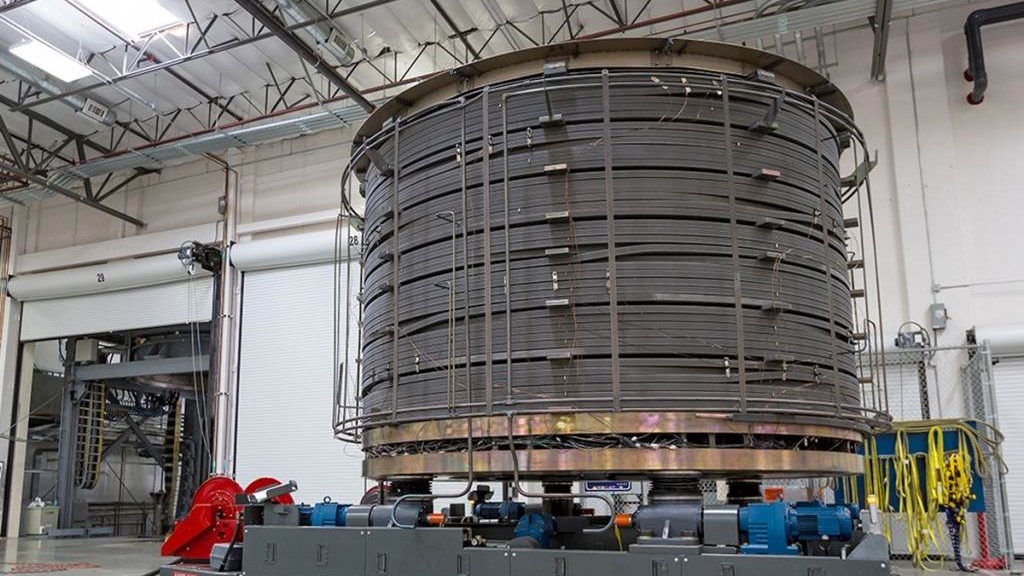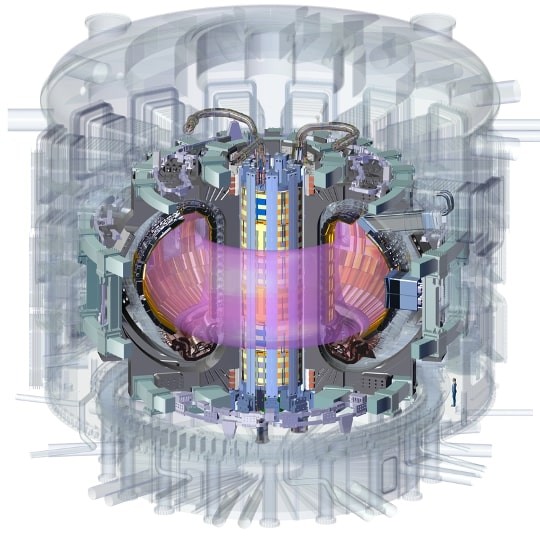World's most powerful magnet begins journey to heart of giant fusion experiment
It will produce a magnetic field 280,000 times stronger than the one made by Earth.

Engineers in the U.S. are preparing to ship the first part of the world's most powerful magnet to France, where it will help power a state-of-the-art nuclear fusion reactor.
The magnet, known as the central solenoid, will make up the heart of the world's largest fusion reactor, ITER, which means "the way" in Latin. This international experiment involves 35 countries and aims to prove the feasibility of sustained nuclear fusion to create energy. In nuclear fusion, smaller atoms are fused to create larger ones — a reaction that releases enormous amounts of energy.
When fully assembled, the central solenoid will be 59 feet (18 meters) tall and 14 feet (4.3 m) wide, and will be capable of producing a magnetic field measuring 13 teslas — around 280,000 times stronger than Earth's magnetic field — making it strong enough to lift an entire aircraft carrier, which weighs around 100,000 tons (90,700 metric tons).
Related: The 18 biggest unsolved mysteries in physics
"The central solenoid is the largest and most powerful pulsed electromagnet ever constructed," John Smith, director of engineering and projects at General Atomics, the company building the magnet, told Live Science.
Central solenoid
The central solenoid is made up of six individual modules that will be stacked inside the center of the ITER reactor. The entire magnet will be as tall as a four-story building and weigh 1,000 tons (907 metric tons).
Each individual module is essentially a big coil containing around 3.5 miles (5.6 kilometers) of steel-jacketed niobium-tin superconducting cable. The module is then heat-treated in a large furnace for several weeks to further increase its conductivity, after which the cables are insulated and the coil is wrapped into its final shape.
Get the world’s most fascinating discoveries delivered straight to your inbox.
According to Faraday's law of induction, electricity passing through a wire generates a magnetic field perpendicular to the wire. When that wire is coiled into a circle, electric current produces a circular magnetic field, and each coil amplifies the magnetic-field strength. A solenoid is thus created by coiling a wire many times. The simplest version of a solenoid is the classic classroom experiment in which students wrap wire around a nail and attach it to a battery. When the battery is turned on, the coil can pick up paper clips.
However, the size and superconductive nature of the central solenoid means far more electric current can pass through it, allowing it to produce a stronger magnetic field than anything ever built.
Heart of ITER
The central solenoid is the "beating heart" of the ITER reactor, because it will allow scientists to control the normally unstable reactants of nuclear fusion.
ITER is designed to release a small amount of vaporized deuterium and tritium, both of which are hydrogen isotopes — or versions of the same element with different atomic masses — into a large, doughnut-shaped vacuum chamber, known as a tokamak. The tokamak superheats these isotopes, stripping away the atoms' electrons and converting the gas into plasma. This ultrahot plasma will reach 270 million degrees Fahrenheit (150 million degrees Celsius), or 10 times hotter than the core of the sun. At this temperature, the atoms undergo fusion, giving off large amounts of energy, which can be used to create electricity by heating water and creating steam to turn turbines.

Nuclear fusion has already been achieved inside several tokamak reactors dating back as far as the 1950s, but it has only ever lasted for a few seconds at a time. For nuclear fusion to become a viable option for generating electricity, this reaction must be maintained at a constant rate and require less energy to produce than it generates.
One of the biggest hurdles to sustained fusion is containing and manipulating the searing plasma inside the reactors.
This is where the central solenoid comes into play. In theory, the powerful magnetic field it creates will pin the plasma in place inside the tokamak and maintain the reaction, Smith said.
On the move
The first central solenoid module, which took more than five years to build, is finally ready to be transported to the ITER site in France.
Engineers are building and transporting each module individually, because the complete magnet would be too large to transport safely, Smith said. The modules are also built separately in case one needs to be replaced, he added.
The module's journey will begin by road. It will be moved from General Atomics' San Diego base to a port in Houston via a massive 24-axle tractor. From there, the monster magnet will be shipped in early July to Marseille, France, and arrive there by late August, before being transported by road again to the ITER facility.

The remaining five modules and an additional backup module will follow the same route when they are completed over the coming few years, Smith said.
International collaboration
Each of the 35 participating countries — which include the entire European Union, as well as the U.K., Switzerland, China, India, Japan, Korea, Russia and the U.S. — have contributed to the project by designing and producing some of the more than 1 million individual reactor components.
The central solenoid is the largest of several U.S. contributions, which make up around 9% of the total cost of ITER, according to engineers. General Atomics is developing additional technologies and components to help aid in plasma manipulation and other U.S. companies and universities are providing cooling and exhaust systems, diagnostics, instrumentation and controls, Smith said.
Despite the impact of the COVID-19 pandemic on such large projects, the construction of ITER remains on track to finish by 2025 and is currently around 75% complete. Full-scale fusion reactions won't take place until 2035 at the earliest, Smith said.
Why is fusion so important?
Sustained nuclear fusion could open the door to unlimited renewable energy, which would slash carbon emissions created by the burning of fossil fuels that contribute to climate change.
"Fusion is one of the few potential options for large-scale carbon-free energy production," Smith said. "It offers a safe, clean, always-on resource that produces no emissions or long-lived waste products."
To halt — or even slow — the planet's warming, wind, solar, tidal and other renewable energy systems must be massively scaled up long before ITER fuses its first atoms. But due to the variability of their energy output (for instance, wind turbines only work when the wind is blowing) we will still have to rely on fossil fuels to ensure the electricity grid provides a reliable supply of power, Smith said.
Therefore, it is vital for sustained nuclear fusion to be achieved as quickly as possible and for the technology to be replicated around the world.
"ITER is a major step in this direction that will demonstrate the physics and technology on the way to fusion power plants," Smith said.
Originally published on Live Science.

Harry is a U.K.-based senior staff writer at Live Science. He studied marine biology at the University of Exeter before training to become a journalist. He covers a wide range of topics including space exploration, planetary science, space weather, climate change, animal behavior and paleontology. His recent work on the solar maximum won "best space submission" at the 2024 Aerospace Media Awards and was shortlisted in the "top scoop" category at the NCTJ Awards for Excellence in 2023. He also writes Live Science's weekly Earth from space series.
